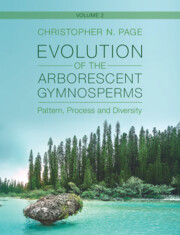Book contents
- Evolution of the Arborescent Gymnosperms: Pattern, Process and Diversity
- Reviews
- Evolution of the Arborescent Gymnosperms
- Copyright page
- Contents
- Preface and Acknowledgements
- Structure of the Volumes
- Part I Aims, Approaches and Diversity
- Part II Phylogenetic Bases and Revised Taxonomic Structure
- Part III Living Arborescent Gymnosperm Genetic Presentations
- Chapter 41 Fitzroya
- Chapter 42 Cryptomeria
- Chapter 43 Glyptostrobus
- Chapter 44 Taxodium
- Chapter 45 Sequoia
- Chapter 46 Sequoiadendron
- Chapter 47 Metasequoia
- Chapter 48 Cunninghamia
- Chapter 49 Taiwania
- Chapter 50 Athrotaxis
- Chapter 51 Araucaria
- Chapter 52 Wollemia
- Chapter 53 Agathis
- Chapter 54 Podocarpus
- Chapter 55 Retrophyllum
- Chapter 56 Nageia
- Chapter 57 Afrocarpus
- Chapter 58 Dacrydium
- Chapter 59 Dacrycarpus
- Chapter 60 Falcatifolium
- Chapter 61 Acmopyle
- Chapter 62 Halocarpus
- Chapter 63 Lagarostrobos
- Chapter 64 Manoao
- Chapter 65 Parasitaxus
- Chapter 66 Prumnopitys
- Chapter 67 Sundacarpus
- Chapter 68 Pectinopitys
- Chapter 69 Microcachrys
- Chapter 70 Pherosphaera
- Chapter 71 Phyllocladus
- Chapter 72 Saxegothaea
- Chapter 73 Lepidothamnus
- Part IV From Ecosystem Services to Conservation and Sustainability
- Selected Bibliography
- Genus Index
- Plate Section (PDF Only)
- References
Chapter 58 - Dacrydium
Podocarpales: Dacrydiaceae
from Part III - Living Arborescent Gymnosperm Genetic Presentations
Published online by Cambridge University Press: 11 November 2024
- Evolution of the Arborescent Gymnosperms: Pattern, Process and Diversity
- Reviews
- Evolution of the Arborescent Gymnosperms
- Copyright page
- Contents
- Preface and Acknowledgements
- Structure of the Volumes
- Part I Aims, Approaches and Diversity
- Part II Phylogenetic Bases and Revised Taxonomic Structure
- Part III Living Arborescent Gymnosperm Genetic Presentations
- Chapter 41 Fitzroya
- Chapter 42 Cryptomeria
- Chapter 43 Glyptostrobus
- Chapter 44 Taxodium
- Chapter 45 Sequoia
- Chapter 46 Sequoiadendron
- Chapter 47 Metasequoia
- Chapter 48 Cunninghamia
- Chapter 49 Taiwania
- Chapter 50 Athrotaxis
- Chapter 51 Araucaria
- Chapter 52 Wollemia
- Chapter 53 Agathis
- Chapter 54 Podocarpus
- Chapter 55 Retrophyllum
- Chapter 56 Nageia
- Chapter 57 Afrocarpus
- Chapter 58 Dacrydium
- Chapter 59 Dacrycarpus
- Chapter 60 Falcatifolium
- Chapter 61 Acmopyle
- Chapter 62 Halocarpus
- Chapter 63 Lagarostrobos
- Chapter 64 Manoao
- Chapter 65 Parasitaxus
- Chapter 66 Prumnopitys
- Chapter 67 Sundacarpus
- Chapter 68 Pectinopitys
- Chapter 69 Microcachrys
- Chapter 70 Pherosphaera
- Chapter 71 Phyllocladus
- Chapter 72 Saxegothaea
- Chapter 73 Lepidothamnus
- Part IV From Ecosystem Services to Conservation and Sustainability
- Selected Bibliography
- Genus Index
- Plate Section (PDF Only)
- References
Summary
Evergreen shrubs to forest trees, to 10–55 m and 1.5 m dbh, with branchlets strongly whorled in origins. Leaves are slender, spreading all around shoots, crowded, densely spirally set on shoots which are spreading to descending or upsweeping or erect towards the tips of the shoots.
- Type
- Chapter
- Information
- Evolution of the Arborescent GymnospermsPattern, Process and Diversity, pp. 399 - 421Publisher: Cambridge University PressPrint publication year: 2024

